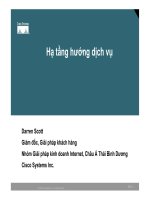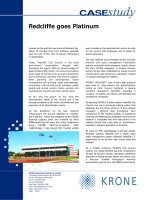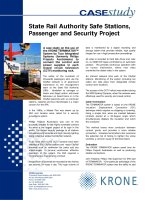Tài liệu Memory Dump Analysis Anthology- P22 pdf
Bạn đang xem bản rút gọn của tài liệu. Xem và tải ngay bản đầy đủ của tài liệu tại đây (964.61 KB, 30 trang )
Dumping Processes Without Breaking Them 631
DUMPING PROCESSES WITHOUT BREAKING THEM
We can do it on any Windows system after Windows 2000 without installing any
additional tools like Userdump or WinDbg. And a process won’t be interrupted while its
memory dump is being saved and will continue to work. We can use the following com-
mand:
ntsd -pvr -p 'PID' -c ".dump /ma /u process.dmp; q"
PID is a decimal process ID we can get from Task Manager, for example.
Note: on x64 system to dump a 32-bit process (shown as *32 in Task Manager)we
need to use NTSD from \Windows\SysWOW64 folder (page 633). On Windows Vista,
NTSD is no longer included but it can be found in Debugging Tools for Windows package.
Please purchase PDF Split-Merge on www.verypdf.com to remove this watermark.
632 PART 11: The Origin of Crash Dumps
USERDUMP.EXE ON X64
If we install the latest Microsoft user mode process dumper on x64 Windows we
would see both x86 and x64 folders.
One advice here: do not dump 32-bit applications and services (shown as *32 in
Task Manager) using userdump.exe from x64 folder: use userdump.exe from x86 folder.
32-bit application runs in WOW64 emulation layer on x64 Windows and that emulation
layer is itself native 64-bit process so x64 userdump.exe saves that emulation layer and
not the original 32-bit application. If we open that dump file in WinDbg we would see
WOW64 thread stacks and not thread stacks from our original 32-bit application.
In summary, on x64 Windows
to save a memory dump file of a 64-bit application we can use:
x64\userdump.exe
\Windows\System32\ntsd.exe
64-bit version of WinDbg.exe
to save a memory dump file of a 32-bit application use:
x86\userdump.exe
\Windows\SysWOW64\ntsd.exe
32-bit WinDbg.exe
Please purchase PDF Split-Merge on www.verypdf.com to remove this watermark.
NTSD on x64 Windows 633
NTSD ON X64 WINDOWS
If we need to attach NTSD to a process on x64 Windows and to save a memory
dump file we should remember that there are two versions of NTSD: x86 (32-bit) and
x64. The former is located in \Windows\SysWOW64 folder and should be used for
attaching to 32-bit applications and services. For explanation why you need different
versions of NTSD please refer to the first picture in Dumps, Debuggers and Virtualiza-
tion (page 516).
If we use WinDbg for that purpose we should install both 32-bit and 64-bit ver-
sions.
If we want to install NTSD or WinDbg as a default postmortem debugger we
should use Wow6432Node registry hive:
HKEY_LOCAL_MACHINE\SOFTWARE\Wow6432Node\Microsoft\Windows
NT\CurrentVersion\AeDebug
Debugger = ntsd -p %ld -e %ld -g -c ".dump /ma /u c:\TEMP\new.dmp; q"
Please refer to the following Citrix support articles explaining and describing in
more detail how to set NTSD and WinDbg as default postmortem debuggers:
How to Set NTSD as a Default Windows Postmortem Debugger
(
How to Set WinDbg as a Default Windows Postmortem Debugger
(
Please purchase PDF Split-Merge on www.verypdf.com to remove this watermark.
634 PART 11: The Origin of Crash Dumps
NEED A DUMP? COMMON USE CASES
The most common scenarios technical support people encounter when facing the
need to create a dump file are:
Heap corruption
the article is applicable to any process.
CPU spikes
No user dumps saved by Dr. Watson
Memory leak
the article is applicable to any process.
Need a system dump from a remote session? Use SystemDump (page 646)
Got correct dump? Use Citrix DumpCheck
(Explorer extension)
(Command line version)
Please purchase PDF Split-Merge on www.verypdf.com to remove this watermark.
Memory Dump Analysis Using Excel 635
PART 12: TOOLS
MEMORY DUMP ANALYSIS USING EXCEL
Some WinDbg commands output data in tabular format so it is possible to save
their output into a text file, import it to Excel and do sorting, filtering, and graph
visualization. Some commands from WinDbg include:
!stacks 1 - Lists all threads with Ticks column so we can sort and filter threads
that had been waiting for no more than 100 ticks, for example.
!irpfind - Here we can create various histograms, for example, IRP distribution
based on [Driver] column.
The following graph depicts thread distribution in PID - TID coordinates on a busy
multiprocessor system with 25 user sessions and more than 3,000 threads:
WinDbg scripts offer the possibility to output various tabulated data via .PRINTF:
0:000> .printf "a\tb\tc"
a b c
Please purchase PDF Split-Merge on www.verypdf.com to remove this watermark.
636 PART 12: Tools
TESTDEFAULTDEBUGGER.NET
Sometimes there are situations when we need to test exception handling to see
whether it works and how to get dumps or logs from it. For example, a customer reports
infrequent process crashes but no crash dumps are saved. Then we can try some
application that crashes immediately to see whether it results in error messages and/or
saved crash dumps. This was the motivation behind TestDefaultDebugger pack-
age. Unfortunately it contains only native applications and we also needed to test .NET
CLR exception handling and see what messages it shows in an environment. This is a
simple program in C# that creates an empty Stack object and then calls its Pop method
which triggers “Stack empty” exception:
The updated package now includes TestDefaultDebugger.NET.exe and can be
downloaded from Citrix support web site:
Please purchase PDF Split-Merge on www.verypdf.com to remove this watermark.
Cons of Symbol Server 637
CONS OF SYMBOL SERVER
Symbol servers are great. However I found that in crash dump analysis the ab-
sence of automatically loaded symbols sometimes helps to identify a problem or at least
gives some directions for further research. It also helps to see which hot fixes or service
packs for a product were installed on a problem computer. The scenario I use some-
times when I analyze crash dumps from product A is the following:
1. Set up WinDbg to point to Microsoft Symbol Server
2. Load a crash dump and enter various commands based on the issue. Some OS
or product A components become visible and their symbols are unresolved.
3. From unresolved OS symbols I’m aware of the latest fixes or privates from
Microsoft
4. From unresolved symbols of the product A and PDBFinder tool I determine the
base product level and this already gives me some directions.
5. I add the base product A symbols to symbol file path and continue my analysis.
6. If unresolved symbols of the product A continue to come up I use PDBFinder
tool again to find corresponding symbols and add them to symbol file path. By
doing that I’m aware of the product A hot fix and/or service pack level.
7. Also from PDBFinder tool I know whether there are any updates to the
component in question.
Of course, all of this works only if we store all PDB files from all our fixes and ser-
vice packs in some location(s) with easily identified names or abbreviations, for
example, PRODUCTA\VER20\SP31\FIX01. Adding symbols manually helps to be focused
on components, gives attention to some threads where they appear. We might think it
is a waste of time but it only takes very small percentage of time especially if we look at
the memory dump for a couple of hours.
What is PDBFinder tool? This is a program I developed to find right symbol files
(especially for minidumps). It scans all locations for PDB or DBG files and adds them to a
binary database. Next time we run PDBFinder tool it loads that database and we can
find PDB or DBG file location by specifying module name and its date. We can also do a
fuzzy search by specifying some date interval. If we run it with -update command line
option it will build the database automatically, useful for scheduling weekly updates.
You can download it from
Please purchase PDF Split-Merge on www.verypdf.com to remove this watermark.
638 PART 12: Tools
STRESSPRINTERS: STRESSING PRINTER AUTOCREATION
Printer drivers are great source of crash dumps especially in Citrix and Microsoft
terminal services environments. Bad printer drivers crash or hang spooler service
(spoolsv.exe) when multiple users connect to a server.
Most of bad drivers were designed and implemented for use in a single
user environment without considering multithreading in mind. Some bad drivers display
a dialog box every time the printer is created and because this is done on a server side
users cannot dismiss it unless spooler service is configured to interact with the desktop
and an administrator sees the dialog box. Some drivers are linked to a debug run-time
library and every exception brings up a dialog effectively hanging the thread and some-
times the whole spooler service if there was heap corruption, for example.
Therefore before allowing terminal services users to use certain printers it is
good to simulate multiple users trying to create particular printers to determine bad
drivers and other printer components. Originally Citrix had very popular command line
AddPrinter tool for this purpose and it has been replaced by StressPrinters tool where I
designed and implemented GUI to set various options, coordination of multiple
AddPrinter command line tools launched simultaneously with different parameters and
overall log file management. We can even export settings to a file and import it on
another server. The tool also has 64-bit executables to test printer autocreation on x64
Windows.
The tool detects spooler crashes (if spoolsv.exe suddenly disappears from a
process list) so we can check for crash dumps saved if we set up a default postmortem
debugger (Dr. Watson or NTSD). If we see the progress bar hanging for a long time then
we can dump the spooler service using Microsoft userdump.exe to check for any stuck
threads and resource contention.
You can read documentation and download this tool from Citrix support:
StressPrinters for 32-bit and 64-bit platforms
Please purchase PDF Split-Merge on www.verypdf.com to remove this watermark.
InstantDump (JIT Process Dumper) 639
INSTANTDUMP (JIT PROCESS DUMPER)
Techniques utilizing user mode process dumpers and debuggers like Microsoft
userdump.exe, NTSD or WinDbg and CDB from Debugging Tools for Windows are too
slow to pick up a process and dump it. We need either to attach a debugger ma-
nually, run the command line prompt or switch to Task Manager. This deficiency was the
primary motivation for me to use JIT (just-in-time) technology for process dumpers. The
new tool, InstantDump, will dump a process instantly and non-invasively in a moment
when we need it. How does it work? We point to any window and press hot key.
InstantDump could be useful to study hang GUI processes or to get several
dumps of the same process during some period of time (CPU spiking case or memory
leak, for example) or just dump the process for the sake of dumping it (for curiosity).
The tool uses tooltips to dynamically display window information.
Here is the short user guide:
1. The program will run only on XP/W2K3/Vista (in fact it will not load on
Windows 2000).
2. Run InstantDump.exe on 32-bit system or InstantDump64.exe on x64 Win-
dows. If we attempt to run InstantDump.exe on x64 Windows it will show this message
box and quit:
3. InstantDump puts itself into task bar icon notification area:
4. By default, when we move the mouse pointer over windows, the tooltip
follows the cursor describing the process and thread id and process image path (we can
disable tips in Options dialog box):
Please purchase PDF Split-Merge on www.verypdf.com to remove this watermark.
640 PART 12: Tools
5. If we hold Ctrl-RightShift-Break for less than a second then the process (which
window is under the cursor) will be dumped according to the settings for external
process dumper in the options dialog (accessible via task bar icon right mouse click):
The saved dump name will be (in our Calculator window case):
calc.exe_9f8(2552)_22-17-56_18-Feb-2007.dmp
There is no NTSD in Vista so we have to use another user mode dumper, for
example, install Microsoft userdump.exe and specify the following command line in
Options dialog:
userdump.exe %d %s
or resort to WinDbg or CDB command line.
The tool can be downloaded from here:
Please purchase PDF Split-Merge on www.verypdf.com to remove this watermark.
TestDefaultDebugger 641
TESTDEFAULTDEBUGGER
It often happens that support engineers advise customers to change their default
postmortem debugger to NTSD. But there is no way to test new settings unless an
application crashes again. And some customers come back saying that dump files are
not saved despite the new settings and we don’t know whether dump files were not
saved because a crash hadn’t yet happened or default debugger hadn’t been configured
properly or something else had happened.
In addition, the arrival of 64-bit Windows brings another problem: there are 2 de-
fault postmortem debuggers on 64-bit Windows, one for 32-bit and one for 64-bit
applications respectively (page 633).
The new tool TestDefaultDebugger forces a crash on itself to test the presence
and configuration of a default postmortem debugger (Dr. Watson, NTSD or other). Then
if the default postmortem debugger is configured properly OS will launch it to save a
memory dump of TestDefaultDebugger.exe process.
If we enabled NTSD as a default postmortem debugger (see
the following console window would
briefly appear:
Please purchase PDF Split-Merge on www.verypdf.com to remove this watermark.
642 PART 12: Tools
Postmortem debuggers are explained on page 28.
On 64-bit Windows we can run both 32-bit TestDefaultDebugger.exe and 64-bit
TestDefaultDebugger64.exe applications and then open crash dumps to see whether
both postmortem debuggers have been configured properly. The tool has also com-
mand line interface so we can use it remotely:
c:\>TestDefaultDebugger.exe now
We can download the tool from Citrix support web site:
TestDefaultDebugger v1.0 for 32-bit and 64-bit platforms
Please purchase PDF Split-Merge on www.verypdf.com to remove this watermark.
DumpAlerts 643
DUMPALERTS
The tool monitors folders where dumps can be saved including Dr. Watson, a
folder specified when NTSD is set as a default debugger and so on. It then alerts a user,
an administrator or a software vendor whenever a new dump file is saved:
Icon in System Tray changes its color from green to red
Popup window appears until dismissed
E-mail is sent to a specified address
Sound is played
Custom action is executed, for example, automatically launching WinDbg.exe
with the latest memory dump file or copying it to an ftp server
All actions are fully configurable and can be enabled/disabled. Here is the screen-
shot of the main window:
Please purchase PDF Split-Merge on www.verypdf.com to remove this watermark.
644 PART 12: Tools
DUMPDEPENDS
There are many cases where we need to dump several processes simultaneously
and complete memory dump is not an option. DumpDepends tool dumps processes and
optionally package them into a CAB file. There are several options:
Dump all processes
Dump important services (Terminal, IMA, CTXXMLSS, Printing, Spooler,
SVCHOST)
Dump all processes from the given session ID (additionally including children
and important services if needed)
Dump an individual process (optionally including children and important ser-
vices)
The tool will use external process dumpers in noninvasive manner (NTSD by de-
fault or any other specified, like userdump.exe). On x64 it will distinguish between 32-
bit and 64-bit processes and dump them accordingly. Command line option will also be
available.
Please purchase PDF Split-Merge on www.verypdf.com to remove this watermark.
Dump Monitor Suite 645
DUMP MONITOR SUITE
Following the announced Troubleshooting Tool Ideas database Ramzy Mansour
from Citrix Technical Support came up with a brilliant idea about Dump Monitor Suite
and its two useful components for Citrix and Microsoft administrators:
DumpStats:
- Monitors and displays a graphical chart showing which services and processes
crashed or hanged on an individual server, their crash time and date, dump loca-
tion, dump type, crash signature and modules where crashes happened.
- Aggregates and displays statistics for the whole server farm.
DumpAlerts:
- Sends an e-mail alert and/or an SMS message to a cell phone when any crash or
hang happens.
- Configures alerts based on severity and specific processes.
Additionally Dump Monitor Suite includes the following components (some of
them already exist):
DumpChecks:
- Enhanced and improved version of Citrix DumpCheck Explorer extension and its
command line version.
DumpProperties:
- New Explorer extension (Properties dialog) which shows various data extracted
from a dump, like process name, module list, whether heap checking was enabled
and module name where crash happened.
DumpDepends:
- Integrated and enhanced version of SystemDump which allows to
dump dependent processes.
Please purchase PDF Split-Merge on www.verypdf.com to remove this watermark.
646 PART 12: Tools
SYSTEMDUMP
It was previously called CtxBSOD v2.1 but was renamed to better show its pur-
pose. In addition to renaming I added a command line option to dump a system re-
motely or from a command line locally without using its GUI interface. The main motiva-
tion to write this tool was the absence of similar tools for 64-bit Windows at that time.
SystemDump can dump a 64-bit server too!
You can download it form Citrix support web site:
Main features:
The tool has both GUI and command line interfaces.
We can type a message/text (or copy it from clipboard) before forcing a mem-
ory dump. This message is saved in a dump file and a support engineer can read
it after loading the dump file in WinDbg.exe. This is implemented to encourage
writing symptoms and conditions explaining why the dump has to be forced.
The tool can stay on top of any window (if we need this to quickly dump the
server after a reproduction or during some activity).
It is supplied with Program Database (PDB) symbols for the driver (32-bit and
64-bit) which is useful when we want to have all symbols to be present on the
bugcheck thread.
The bugcheck clearly shows that the dump was manually generated.
The tool can force a memory dump on both 32-bit and 64-bit platforms.
Please purchase PDF Split-Merge on www.verypdf.com to remove this watermark.
SystemDump 647
Before forcing a fatal error on a server, the tool warns about potential damag-
ing consequences: users are disconnected and all the data which is not saved
will be lost. It asks for a confirmation.
We can specify a period of time (in minutes) when to force a memory dump.
The latter feature is implemented entirely in kernel. The following command:
>SystemDump.exe abort
allows us to abort the action if we ran the tool using command line options.
Here is the UML component diagram showing the architecture of this tool.
User Mode/Space
CtxBSOD.sys
IOCTL
Driver(Init,Unload)
SCM (services.exe)
ntoskrnl.exe
NtLoadDriver
CtxBSOD (SCP)
Service API
advapi32.dll
ntdll.dll
kernel32.dll
RPC
DeviceIoControl
NtLoadDriver
Kernel Mode/
Space
Please purchase PDF Split-Merge on www.verypdf.com to remove this watermark.
648 PART 12: Tools
Please purchase PDF Split-Merge on www.verypdf.com to remove this watermark.
What is KiFastSystemCallRet? 649
PART 13: MISCELLENEOUS
WHAT IS KIFASTSYSTEMCALLRET?
This is a return function address for trap frames created for system calls on x86
post-W2K systems.
Since Pentium II Microsoft changed OS call dispatching from interrupt dri-
ven INT /IRETD mechanism used in Windows NT and Windows 2000 to faster optimized
instruction sequence. This is SYSENTER / SYSEXIT pair on x86 32-bit Intel platforms and
SYSCALL / SYSRET pair on x64 Intel and AMD platforms.
INT instruction saves a return address but SYSENTER doesn’t. Let’s look at a typi-
cal thread call stack a from complete memory dump coming from x86 Windows 2003
system:
1: kd> kL
ChildEBP RetAddr
a5a2ac64 80502d26 nt!KiSwapContext+0x2f
a5a2ac70 804faf20 nt!KiSwapThread+0x8a
a5a2ac98 805a4d6c nt!KeWaitForSingleObject+0x1c2
a5a2ad48 8054086c nt!NtReplyWaitReceivePortEx+0x3dc
a5a2ad48 7c91eb94 nt!KiFastCallEntry+0xfc
00a0fe18 7c91e399 ntdll!KiFastSystemCallRet
00a0fe1c 77e56703 ntdll!NtReplyWaitReceivePortEx+0xc
00a0ff80 77e56c22 RPCRT4!LRPC_ADDRESS::ReceiveLotsaCalls+0xf4
00a0ff88 77e56a3b RPCRT4!RecvLotsaCallsWrapper+0xd
00a0ffa8 77e56c0a RPCRT4!BaseCachedThreadRoutine+0×79
00a0ffb4 7c80b683 RPCRT4!ThreadStartRoutine+0×1a
00a0ffec 00000000 kernel32!BaseThreadStart+0×37
RPC module calls the native function to wait for a reply from an LPC port. Note
that we disassemble the return address instead of the symbolic address because of
OMAP Code Optimization:
1: kd> ub RPCRT4!LRPC_ADDRESS::ReceiveLotsaCalls+0xf4
^ Unable to find valid
previous instruction for 'ub RPCRT4!LRPC_ADDRESS::ReceiveLotsaCalls+0xf4'
Please purchase PDF Split-Merge on www.verypdf.com to remove this watermark.
650 PART 13: Miscelleneous
1: kd> ub 77e56703
RPCRT4!LRPC_ADDRESS::ReceiveLotsaCalls+0xd9:
77e566e8
e8edfeffff call RPCRT4!RpcpPurgeEEInfoFromThreadIfNecessary
(77e565da)
77e566ed ff75ec push dword ptr [ebp-14h]
77e566f0 8d45f0 lea eax,[ebp-10h]
77e566f3 ff75f4 push dword ptr [ebp-0Ch]
77e566f6 ff75fc push dword ptr [ebp-4]
77e566f9 50 push eax
77e566fa ff7658 push dword ptr [esi+58h]
77e566fd ff15b010e577 call dword ptr
[RPCRT4!_imp__NtReplyWaitReceivePortEx (77e510b0)]
1: kd> dps 77e510b0 l1
77e510b0 7c91e38d ntdll!ZwReplyWaitReceivePortEx
NTDLL stub for the native function is small and transitions to level 0 via shared
SystemCallSub immediately:
1: kd> uf ntdll!NtReplyWaitReceivePortEx
ntdll!ZwReplyWaitReceivePortEx:
7c91e38d mov eax,0C4h
7c91e392 mov edx,offset SharedUserData!SystemCallStub (7ffe0300)
7c91e397 call dword ptr [edx]
7c91e399 ret 14h
1: kd> dps 7ffe0300 l3
7ffe0300 7c91eb8b ntdll!KiFastSystemCall
7ffe0304 7c91eb94 ntdll!KiFastSystemCallRet
7ffe0308 00000000
1: kd> uf ntdll!KiFastSystemCall
ntdll!KiFastSystemCall:
7c91eb8b mov edx,esp
7c91eb8d sysenter
7c91eb8f nop
7c91eb90 nop
7c91eb91 nop
7c91eb92 nop
7c91eb93 nop
7c91eb94 ret
Before executing SYSENTER ESP points to the following return address:
1: kd> u 7c91e399
ntdll!NtReplyWaitReceivePortEx+0xc:
7c91e399 ret 14h
Please purchase PDF Split-Merge on www.verypdf.com to remove this watermark.
What is KiFastSystemCallRet? 651
SYSENTER instruction changes ESP and EIP to new values contained in machine-
specific registers (MSR). As a result EIP points to nt!KiFastCallEntry. After saving a trap
frame and checking parameters it calls nt!NtReplyWaitReceivePortEx address from the
system function table. When the latter function returns KiFastCallEntry proceeds to
KiServiceExit and KiSystemCallExit2:
1: kd> ub 8054086c
nt!KiFastCallEntry+0xe2:
80540852 mov ebx,dword ptr [edi+eax*4]
80540855 sub esp,ecx
80540857 shr ecx,2
8054085a mov edi,esp
8054085c cmp esi,dword ptr [nt!MmUserProbeAddress (80561114)]
80540862 jae nt!KiSystemCallExit2+0×9f (80540a10)
80540868 rep movs dword ptr es:[edi],dword ptr [esi]
8054086a call ebx
1: kd> u
nt!KiFastCallEntry+0x105:
80540875 mov edx,dword ptr [ebp+3Ch]
80540878 mov dword ptr [ecx+134h],edx
nt!KiServiceExit:
8054087e cli
8054087f test dword ptr [ebp+70h],20000h
80540886 jne nt!KiServiceExit+0x10 (8054088e)
80540888 test byte ptr [ebp+6Ch],1
8054088c je nt!KiServiceExit+0x66 (805408e4)
8054088e mov ebx,dword ptr fs:[124h]
1: kd> u
nt!KiSystemCallExit2+0x12:
80540983 sti
80540984 sysexit
Let’s inspect the trap frame:
1: kd> kv5
ChildEBP RetAddr Args to Child
a5a2ac64 80502d26 82ffc090 82ffc020 804faf20 nt!KiSwapContext+0x2f
a5a2ac70 804faf20 e12424b0 8055c0a0 e12424b0 nt!KiSwapThread+0x8a
a5a2ac98 805a4d6c 00000001 00000010 00000001
nt!KeWaitForSingleObject+0x1c2
a5a2ad48 8054086c 000000c8 00a0ff70 00000000
nt!NtReplyWaitReceivePortEx+0x3dc
a5a2ad48 7c91eb94 000000c8 00a0ff70 00000000 nt!KiFastCallEntry+0xfc
(TrapFrame @ a5a2ad64)
Please purchase PDF Split-Merge on www.verypdf.com to remove this watermark.
652 PART 13: Miscelleneous
1: kd> .trap a5a2ad64
ErrCode = 00000000
eax=00000000 ebx=00000000 ecx=00a0fd6c edx=7c91eb94 esi=00159b38
edi=00000100
eip=7c91eb94 esp=00a0fe1c ebp=00a0ff80 iopl=0 nv up ei pl zr na pe nc
cs=001b ss=0023 ds=0023 es=0023 fs=003b gs=0000 efl=00000246
ntdll!KiFastSystemCallRet:
001b:7c91eb94 ret
1: kd> kL
*** Stack trace for last set context - .thread/.cxr resets it
ChildEBP RetAddr
00a0fe18 7c91e399 ntdll!KiFastSystemCallRet
00a0fe1c 77e56703 ntdll!NtReplyWaitReceivePortEx+0xc
00a0ff80 77e56c22 RPCRT4!LRPC_ADDRESS::ReceiveLotsaCalls+0xf4
00a0ff88 77e56a3b RPCRT4!RecvLotsaCallsWrapper+0xd
00a0ffa8 77e56c0a RPCRT4!BaseCachedThreadRoutine+0x79
00a0ffb4 7c80b683 RPCRT4!ThreadStartRoutine+0x1a
00a0ffec 00000000 kernel32!BaseThreadStart+0x37
Therefore it looks that the dummy ntdll!KiFastSystemCallRet function with one
RET instruction is used to create a uniform trap frame across system calls. Otherwise
trap frames for different native API calls would have contained different return values.
Please purchase PDF Split-Merge on www.verypdf.com to remove this watermark.
Understanding I/O Completion Ports 653
UNDERSTANDING I/O COMPLETION PORTS
Many articles and books explain Windows I/O completion ports from high level
design considerations arising when building high-performance server software. But it is
hard to recall them later when someone asks to explain and not everyone writes that
software. Looking at complete memory dumps has an advantage of a bottom-up or re-
verse engineering approach where we see internals of server software and can imme-
diately grasp the implementation of certain architectural and design decisions.
Consider this thread stack trace we can find almost inside any service or network
application process:
THREAD 86cf09c0 Cid 05cc.2030 Teb: 7ffd7000 Win32Thread: 00000000 WAIT:
(Unknown) UserMode Non-Alertable
8a3bb970 QueueObject
86cf0a38 NotificationTimer
Not impersonating
DeviceMap e15af5a8
Owning Process 8a3803d8 Image: svchost.exe
Wait Start TickCount 2131621 Ticks: 1264 (0:00:00:19.750)
Context Switch Count 6
UserTime 00:00:00.000
KernelTime 00:00:00.000
Win32 Start Address RPCRT4!ThreadStartRoutine (0×77c5de6d)
Start Address kernel32!BaseThreadStartThunk (0×77e6b5f3)
Stack Init ba276000 Current ba275c38 Base ba276000 Limit ba273000 Call 0
Priority 8 BasePriority 8 PriorityDecrement 0
ChildEBP RetAddr
ba275c50 8083d3b1 nt!KiSwapContext+0×26
ba275c7c 8083dea2 nt!KiSwapThread+0×2e5
ba275cc4 8092b205 nt!KeRemoveQueue+0×417
ba275d48 80833a6f nt!NtRemoveIoCompletion+0xdc
ba275d48 7c82ed54 nt!KiFastCallEntry+0xfc
0093feac 7c821bf4 ntdll!KiFastSystemCallRet
0093feb0 77e66142 ntdll!NtRemoveIoCompletion+0xc
0093fedc 77c604c3 kernel32!GetQueuedCompletionStatus+0×29
0093ff18 77c60655 RPCRT4!COMMON_ProcessCalls+0xa1
0093ff84 77c5f9f1 RPCRT4!LOADABLE_TRANSPORT::ProcessIOEvents+0×117
0093ff8c 77c5f7dd RPCRT4!ProcessIOEventsWrapper+0xd
0093ffac 77c5de88 RPCRT4!BaseCachedThreadRoutine+0×9d
0093ffb8 77e6608b RPCRT4!ThreadStartRoutine+0×1b
0093ffec 00000000 kernel32!BaseThreadStart+0×34
We see that I/O completion port is implemented via kernel queue object so re-
quests (work items, completion notifications, etc) are stored in that queue for further
processing by threads. The number of active threads processing requests is bound to
some maximum value that usually corresponds to the number of processors:
Please purchase PDF Split-Merge on www.verypdf.com to remove this watermark.
654 PART 13: Miscelleneous
0: kd> dt _KQUEUE 8a3bb970
ntdll!_KQUEUE
+0x000 Header : _DISPATCHER_HEADER
+0x010 EntryListHead : _LIST_ENTRY [ 0x8a3bb980 - 0x8a3bb980 ]
+0x018 CurrentCount : 0
+0×01c MaximumCount : 2
+0×020 ThreadListHead : _LIST_ENTRY [ 0×86cf0ac8 - 0×89ff9520 ]
0: kd> !smt
SMT Summary:
KeActiveProcessors: ** (00000003)
KiIdleSummary: ** (00000003)
No PRCB Set Master SMT Set IAID
0 ffdff120 Master **—————————— (00000003) 00
1 f772f120 ffdff120 **—————————— (00000003) 01
Kernel work queues are also implemented via the same queue object as we
might have guessed already:
THREAD 8a777660 Cid 0004.00d0 Teb: 00000000 Win32Thread: 00000000 WAIT:
(Unknown) UserMode Non-Alertable
808b707c QueueObject
Not impersonating
DeviceMap e1000928
Owning Process 8a780818 Image: System
Wait Start TickCount 2615 Ticks: 2130270 (0:09:14:45.468)
Context Switch Count 301
UserTime 00:00:00.000
KernelTime 00:00:00.000
Start Address nt!ExpWorkerThread (0×8082d92b)
Stack Init f71e0000 Current f71dfcec Base f71e0000 Limit f71dd000 Call 0
Priority 12 BasePriority 12 PriorityDecrement 0
Kernel stack not resident.
ChildEBP RetAddr
f71dfd04 8083d3b1 nt!KiSwapContext+0×26
f71dfd30 8083dea2 nt!KiSwapThread+0×2e5
f71dfd78 8082d9c1 nt!KeRemoveQueue+0×417
f71dfdac 809208fc nt!ExpWorkerThread+0xc8
f71dfddc 8083fc9f nt!PspSystemThreadStartup+0×2e
00000000 00000000 nt!KiThreadStartup+0×16
0: kd> dt _KQUEUE 808b707c
ntdll!_KQUEUE
+0x000 Header : _DISPATCHER_HEADER
+0x010 EntryListHead : _LIST_ENTRY [ 0x808b708c - 0x808b708c ]
+0x018 CurrentCount : 0
+0×01c MaximumCount : 2
+0×020 ThreadListHead : _LIST_ENTRY [ 0×8a77a128 - 0×8a777768 ]
Please purchase PDF Split-Merge on www.verypdf.com to remove this watermark.
Understanding I/O Completion Ports 655
I’ve created the simple UML diagram showing high-level relationship between
various objects seen from crash dumps. Note that Active Thread object can process
items from more than one completion port if its wait was satisfied for one port and then
for another but I have never seen this. Obviously Waiting Thread can wait only for one
completion port.
Please purchase PDF Split-Merge on www.verypdf.com to remove this watermark.









